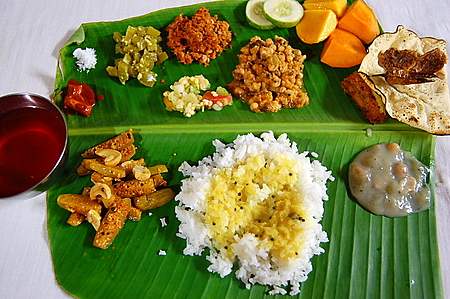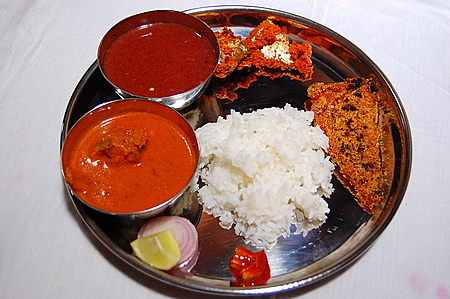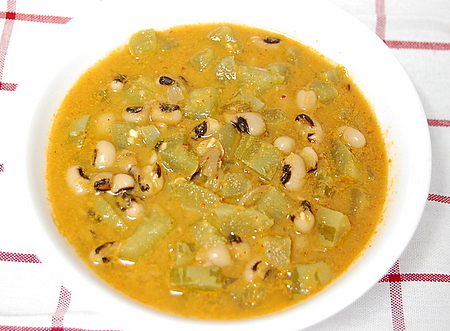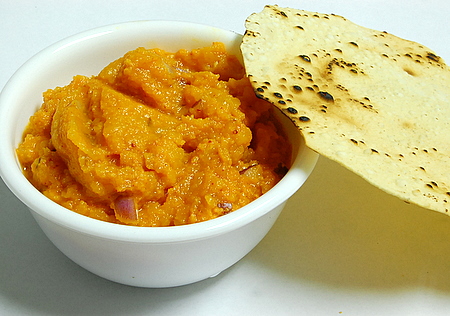Shilpa of ‘Aayis Recipes’ needs no introduction. She is a prolific food blogger who regularly updates her blog with simple everyday recipes with a focus on Konkani food. I admire Shilpa for her dedication to bring Konkani recipes on the world food map and has even got her Aayi (mother) to blog about food.
I asked Shilpa to write an article on traditional Konkani food and she readily accepted to do one. In today’s essay on Konkani cuisine, she enriches our culinary knowledge with two traditional recipes of North Canara region of Karnataka and also gives us a glimpse of traditional thalis of Konkan region. There is no denying that authentic recipes are often diluted with changing tastes and preferences. Hope our humble attempt will motivate our younger generation, especially those living away from home, to appreciate, learn and cook our traditional foods. And let’s hope our traditional cuisines survive for our future generations.
Thank you, Shilpa, for taking time to write a wonderful article on your home cuisine. Friends, please welcome Shilpa. 🙂
~ Sailaja
An Essay on Konkan Cuisine
Konkan region is the beautiful thin strip on the west coast of India. Along with the state languages spoken, Konkani is one of the widely spoken languages. There are many different dialects of Konkani, which is usually a mix of Konkani words plus the other languages. There are a lot of unique words in each dialects.
My family is from North Kanara. So this post will mostly focus on the North Kanara Konkani food. Like all other communities in India, for food, Konkanis mostly rely on, what is grown in their backyards. So a typical Konkani home in North Kanara would have a big yard dominated by coconut trees – that is the reason coconut is a primary ingredient in the food. These days all other vegetables are readily available in markets, but still lot of people rely mainly on coconut based food. Coconut oil is mainly used in almost all dishes. Over the past decade, people are getting more and more health conscious and moving away from coconut consumption, but still it’s maintaining it’s lead I believe.
Along with coconut, the other trees/plants you could find easily here are –
• Teppal which is an important and niche spice. This is used both in vegetarian and non vegetarian dishes alike. Ask anyone from this place and you would definitely hear – tappla ambat (a coconut gravy with teppal).
• Bimbal is also used as a souring agent.
• Tamarind trees are not a common sight as the other two. But you can spot a few. Although tamarind is used very frequently in cooking.
• Ambade used both as souring agents and to make pickles.
Then you can also see jackfruit, mango, drum stick trees, so fruits from these trees constitute a large proportion of Konkani food.
Food served in a normal day. Well, this is not the complete list, I am picking out few that are coming to my mind at this point.
Breakfast – Popular breakfasts on a typical day are –
• Udida pole
• Idlis,
• Surnali,
• Puris,
• Bhakri,
• alayile pita rotti, buns,
• tausalli,
• uppittu,
• abhibhakri,
• kalayile phovu etc.
Some specialties in this category can be –
• Kadamb,
• Shevayi
A rice congee prepared from boiled rice is served at around 11 AM along with either pickle, papad or some kind of side dish. This is fast disappearing these days as people either do not have time for this “mini-meal” or breakfast, lunch replacing it.
Lunch and dinner – A typical Konkani vegetarian thali looks like the image below.
Like most south Indians, I guess Konkani people find rice to be their primary food in the lunches and dinners.
Typical side dishes served are –
Urad papads which are roasted directly on the flame, pickles and then some kind of vegetable.
Side dishes could be broadly classified as –
• Upkaris – These are simple vegetable dishes having a seasoning and garnished with few fresh coconut shavings. For spice, green chilli or red chilli powder is used and the vegetable is cooked in seasoning and little water. For example, beans upkari, tendli upkari(http://www.aayisrecipes.com/2006/07/04/ivygourd-sidedish-tendli-upkari/)
• Talasanis – The main difference between these and upkaris is, here the vegetable is stir fried and cooked in more oil (than using water). Usually red chilli powder is used here. Ex: Tendli talasani, batate talasani etc
• Randayis – These have a base of coconut, usually have a combination of pulses and vegetable (there are randayis with pulses alone or vegetables alone too). The coconut paste is usually watery and the dish looks mostly like gravies. But these are served on the side. The most popular in this category must be – dudde randayi, muga mole randayi. There are many such combinations that are very popular.
• Sukke, sagle – These also have a base of coconut. But unlike randayis, these have a dry(sukke) paste. Ex : navalkola sukke, vayngana sagle etc.
• Phodis – A masala is applied to different vegetable pieces, then they are rolled in sooji and tava fried.
• Apart from these, we have kosambaris/kismuris, bharth, sasam etc.
Gravies –
Ambat is usually a coconut based gravy. Some times it can have both coconut masala and toor dal as in dali ambat, or just coconut masala like in almbe ambat.
Tamblis/tambolis are normally uncooked like kande tamboli.
Saru is more like rasam which has thin soup like consistency for ex tomato saru
Then there are others like rosu/ghashi, thoy, varn etc.
Sweets –
On regular days sweet dishes are usually not served. But on special occasions, different types of sweets are served. The most popular being paays (payasam) . They can be broadly classified into sugar paays (sakkre paays) and jaggery paays (goDa paays) depending on the sweetening agent used. Most loved in this category are shevya paays, sabutandla paays, tandla paays.
The meals are usually accompanied by a cup of plain buttermilk or in kokum season, a cup of kokum kadi.
So far I mentioned only about vegetarian food. Most of the Konkanis in our area are fish eaters. (This does not apply to all. There are many strict vegetarians who do not even prefer garlic and onion in their food). Though chicken is getting more and more popular these days, fish is a primary non-veg choice. A typical Konkani non-veg thali looks like, this one.
Fish gravies usually have a coconut base – either a gravy with coconut and onion which is called alle kande ambat or teppal and coconut which are called tepla ambat. There are some more which have one ingredient more or less.
Fish fries – fishes are marinated in spicy masala and then rolled in sooji and fried.
Dhoddak – A unique kind of preparation which is cooked in ‘dum biryani style’.
There are many more that I have missed in this post. But I can say this pretty much gives an idea of a typical Konkani meal from North Kanara. I am not claiming this to be a reference guide for Konkani food nor am I claiming this to be an accurate representation that different regions of Konkani people follow when it comes to food.
Here is one of my all time favorite randayi that I cooked for this post.
Snake gourd sidedish (padwale randayi)
Ingredients:
1 cup snake gourd pieces
1 cup black eyed peas
1 cup fresh/frozen coconut
5 red chillies
4-5 teppal
2 kokum pieces
1 tea spn jaggery(optional)
Salt
Method:
Cook snake gourd and black eyed peas. Take care not to mash the peas.
Grind coconut along with red chillies to a smooth paste.
Add the paste to cooked snake gourd and black eyed pieces. Throw in kokum, salt, jaggery. Slightly crush teppal in 1 tbl span water (do not make a paste. It is crushed just to bring out the aroma). Add it along (along with the water) to the dish. Cook for 5-6 mins. The dish should not become too dry or too watery.
Pumpkin chutney(dudde bharth)
2 cups chopped pumpkin
5 red chillies
1/2 cup coconut
1/4 tea spn tamarind extract
1/4 cup chopped onion
Salt
Method:
Pressure cook pumpkin pieces(after removing the skin). Cool to room temperature.
Grind together coconut, chillies, tamarind, salt(do not add too much water, it should be chutney consistency).
Add the pumpkin pieces to chutney and mash with a spoon.
While serving, mix a little salt with onion and mix with the pumpkin chutney.
Serve with a urad papad.
Thanks a lot, Sailu, for giving me an opportunity to showcase my regional cuisine from North Canara – Konkani food.
Article, Images and Recipes – Shilpa
Earlier on Indian Food Trail
Maharastra
A Simple Summer Meal by Nupur
Traditional Maharashtrian Thalis – Veg & Non-Veg by Meera
Traditional Maharastrian Sweet & Snacks by Meera























